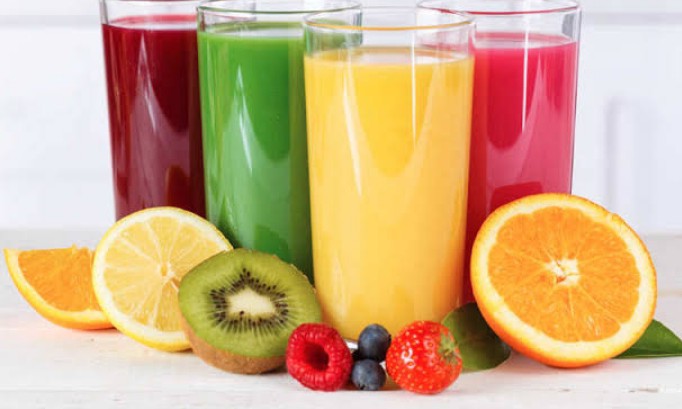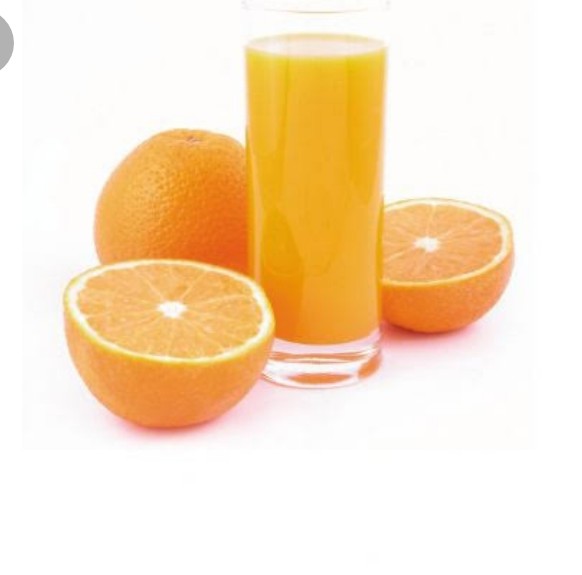
Fruit juices in glass cups
By Adam Rowden (MNT)
Concentrate vs. not from concentrate
Recommended intake
Types of fruit juice
Risks
There are a variety of different fruit juices that a person can drink. These include orange juice, cranberry juice, apple juice, and others. Different fruit juices offer various health benefits, but some risks are also associated with drinking large amounts of certain juices.
Fruit juice comes from the flesh of the fruit or from the whole fruit itself. The method of making fruit juice varies depending on the fruit, but many manufacturers make juice by crushing or “pressing” the fruit to squeeze out the juice inside, then pasteurizing or adding preservatives before packaging the final product.
Though many fruit juices have health benefits, consuming too much fruit juice can cause health complications for people, such as weight gain or changes to blood sugar levels.
This article discusses the different fruit juices available, their health benefits, and certain risks.
The difference between ‘concentrate’ and ‘not from concentrate’ juices
Manufacturers often describe fruit juices as “from concentrate” and “not from concentrate”. This refers to the manufacturing process.
Producers make juice that is “not from concentrate” by juicing the fruit before pasteurizing it. Pasteurizing involves heating the juice to kill pathogens. Manufacturers then package the juice and sell it.
Juice that manufacturers describe as “from concentrate” has one extra step in its manufacturing process. Firstly, the producers juice the fruit. They then filter it in a process that extracts the water from the juice. This means the juice takes up less space during transportation.
Before pasteurizing, makers add water back to the juice concentrate. After pasteurizing, manufacturers then package the juice for sale.
How much fruit juice is healthy?
Eating the daily recommended amount of fruits and vegetables can help people reduce their risk of many leading causes of illness and death. These include cardiovascular disease, type 2 diabetes, some cancers, and obesity.
According to the Centers for Disease Control and Prevention (CDC) the daily recommended amount of fruit is:
Adult females: At least 1 and a half cups of fruit per day
Adult males: At least 2 cups of fruit per day
The United States Department of Agriculture (USDA) states that at least half of the daily recommended amount of fruit should come from whole fruit. This means that a person should not get their daily recommended allowance from fruit juice alone.
The CDC states that only 12% of adults in the United States consume the recommended amount of fruit.
Compared to whole fruit, fruit juice tends to offer less fiber content and more calories and sugar content.
That is why a person should limit the amount of fruit juice they drink each day.
Some research suggests that high levels of fruit juice may not be good for children as they contain large amounts of sugars.
The American Academy of Pediatrics recommends the following maximum daily amounts of fruit juice for children:
Children aged 1–3 years old: No more than 4 ounces of fruit juice per day
Children aged 4–6 years old: 4–6 oz of fruit juice per day
Children aged 7 years old and above: 8 oz of fruit juice per day
Adults should limit themselves to no more than 8 oz of fruit juice per day.
Types of fruit juice
There are many popular fruit juices available, with varying health benefits depending on the fruits they derive from.
Orange juice

Below is the nutritional value of 1 cup (240 ml) of orange juice.
Calories: 117
Protein: 1.7 grams
Carbs: 27.4 g
Fiber: 0.7 g
Sugar: 21.8 g
Potassium: 10% of the Daily Value (DV)
Vitamin C: 83% of the DV
Orange juice is a good source of vitamin C. Vitamin C is an antioxidant, which can help protect against certain health issues.
Vitamin C in orange juice may help a person reduce their risk of developing several health problems, including:
types of cancers
cardiovascular disease
age-related macular degeneration (AMD) and cataracts
common cold
Vitamin C can also help a person maintain their skin health.
Orange juice is also a good source of folate, which plays an important role in DNA synthesis and helps support fetal growth and development.
However, some of these nutrients become lost during processing and storage. One study showed that store-bought orange juice contained 15% less vitamin C and 27% less folate than home-squeezed orange juice.
Cranberry juice
Below is the nutritional value of 1 cup (240 ml) of cranberry juice.
Calories: 116
Protein: 1 g
Carbs: 31 g
Fiber: 0.25 g
Sugar: 31 g
Potassium: 4% of the DV
Vitamin C: 26% of the DV
Vitamin E: 20% of the DV
Vitamin K: 11% of the DV
One well-known benefit of cranberry juice is its ability to reduce a person’s risk of developing a urinary tract infection (UTI).
Cranberry juice and cranberry extract are useful in helping prevent UTIs. However, they are not an effective treatment if a person already has a UTI.
Cranberry juice also contains antioxidants, and studies have shown that it can have positive effects on blood pressure, glucose metabolism, cholesterol, oxidative stress, and inflammation.
Prune juice
Prunes are dried plums. Below is the nutritional value of 1 cup (240 ml)Trusted Source of prune juice.
Calories: 182
Protein: 1.5 g
Carbs: 45 g
Fiber: 2.5 g
Sugar: 42 g
Iron: 17% of the DV
Magnesium: 9% of the DV
Manganese: 17% of the DV
Potassium: 15% of the DV
Vitamin B2: 14% of the DV
Vitamin B3: 13% of the DV
Vitamin B6: 33% of the DV
Vitamin C: 12% of the DV
Vitamin K: 8% of the DV
Prune juice is a good source of several B vitamins. These vitamins have some health benefits, including:
keeping the skin, eyes, and nervous system healthy
helping the body release energy from food
helping with red blood cell production
Prune juice is also a common and effective treatment option for constipation, particularly in older adults.
Prune juice can be high in sugar, so a person should limit the amount that they drink.
Pomegranate juice
Below is the nutritional value of 1 cup (240 ml) of pomegranate juice.
Calories: 134
Protein: less than 1 g
Carbs: 33 g
Fiber: 0.25 g
Sugar: 32 g
Potassium: 12% of the DV
Vitamin C: less than 1% of the DV
Vitamin K: 22% of the DV
Pomegranate juice is a good source of vitamin K. There are several benefits to vitamin K. It has been linked with improving memory in older people and improving heart healthTrusted Source.
It is also high in antioxidants, which can help people combat a variety of health issues.
Tomato juice
Despite a common misconception, tomatoes are fruits and not vegetables.
Below is the nutritional value of 1 cup (240 ml) of tomato juice.
Calories: 41
Protein: 2 g
Carbs: 9 g
Fiber: 1 g
Sugar: 6 g
Folate: 12% of the DV
Potassium: 11% of the DV
Vitamin A: 6% of the DV
Vitamin C: 189% of the DV
Vitamin E: 5% of the DV
Vitamin K: 5% of the DV
Tomato juice is high in vitamin C. Similar to orange juice, this means that it can help lower a person’s risk of certain types of cancers, cardiovascular disease, AMD and cataracts, and the common cold. Vitamin C in tomato juice can also help maintain skin health.
Tomato juice is also a good source of lycopene. This is an antioxidant that gives tomatoes their red color. Studies show that consuming lycopene can reduce a person’s risk of developing cardiovascular disease.
Tomato juice is also a good source of potassium. Potassium is an electrolyte that helps the body to maintain fluid and blood levels.
Potassium can decrease blood pressure, which is beneficial for people with high blood pressure. Increased potassium intake can also reduce a person’s risk of heart disease and stroke.
Tomato juice can also be high in salt. Too much salt can be harmful and can cause cardiovascular problems while also increasing blood pressure. People should try to choose tomato juice without added salt.
Risks of too much juice
There are some risks associated with drinking too much fruit juice.
Many fruit juices are high in sugar and calories. It is important that a person does not consume too much sugar as this can lead to several health issues, such as weight gain, type 2 diabetes, and heart disease.
Some studies show a link between type 2 diabetes and sugary drinks, which includes fruit juice.
A person can also gain weight if they consume too many calories.
Consuming large amounts of orange and grapefruit juice may also increase a person’s risk of developing skin cancer.
One 2015 study states that people who consumed large quantities of whole grapefruit or orange juice were over a third more likely to develop melanoma than people who consumed smaller amounts.
This study looked at the consumption of both whole fruit and fruit juice. That means this is not exclusive to orange and grapefruit juice but also applies to whole oranges and grapefruits. However, this is just one study. More research is necessary to determine if there is a link between the consumption of these fruits and an increased risk of melanoma.







